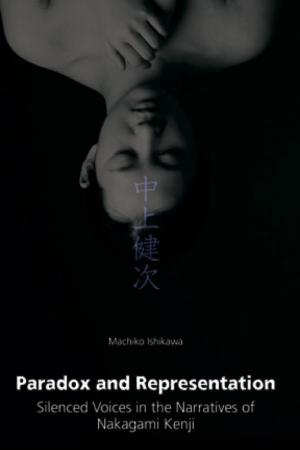Paradox and Representation: Silenced Voices in the Narratives of Nakagami Kenji

How can the "voiceless" voice be represented?
This primary question underpins Ishikawa’s analysis of selected work by Buraku writer, Nakagami Kenji (1946-1992). In spite of his Buraku background, Nakagami’s privilege as a writer made it difficult for him to “hear” and “represent” those voices silenced by mainstream social structures in Japan. This “paradox of representing the silenced voice” is the key theme of the book. Gayatri Spivak theorizes the (im)possibility of representing the voice of “subalterns,” those oppressed by imperialism, patriarchy and heteronormativity. Arguing for Burakumin as Japan's “subalterns,” Ishikawa draws on Spivak to analyze Nakagami’s texts.
The first half of the book revisits the theme of the transgressive Burakumin man. This section includes analysis of a seldom discussed narrative of a violent man and his silenced wife. The second half of the book focuses on the rarely heard voices of Burakumin women from the Akiyuki trilogy. Satoko, the prostitute, unknowingly commits incest with her half-brother, Akiyuki. The aged Yuki sacrifices her youth in a brothel to feed her fatherless family. The mute Moyo remains traumatized by rape. Ishikawa’s close reading of Nakagami’s representation of the silenced voices of these sexually stigmatized women is this book’s unique contribution to Nakagami scholarship.
About the Author
Dr. Machiko Ishikawa received her PhD in 2015 from the Faculty of Arts at the University of Tasmania. During her doctoral candidature, she was appointed as a sessional lecturer and research assistant in the Faculty’s Department of Japanese. Machiko also spent time at Waseda University in Tokyo as a Japan Foundation Doctoral Fellow. After being awarded her doctorate, she took a lecturing position at Surugadai University in Saitama, Japan. A literary studies major, Dr Ishikawa is currently investigating the work of Japanese writers such as Nakagami Kenji, Himeno Kaoruko and Hayashi Mariko. She is also using a post-colonial theory, subaltern studies and gender studies approach to investigate the writing of Tasmanian authors such as Richard Flanagan and Danielle Wood. She is particularly interested in representations of First Nations Australians in these works. Machiko is a member of the Japanese Studies Association of Australia, the Australia and New Zealand Literary Society of Japan and Association for Cultural Typhoon (Japan). Her recent publications include “Exclusionism and the Burakumin: Literary Movement, Legislative Countermeasures and the Sayama Incident,” Cultural and Social Division in Contemporary Japan: Rethinking Discourses of Inclusion and Exclusion (2019): 165–83 and “Kimono as Katami and Remembrance of a Woman in the Narratives of Hayashi Mariko,” Gender, Costume, Textiles, Technique: A Century of Women’s Lives and Japan forthcoming from Brill.
Book
49.95
Additional Information
Program
Type
- Book
- Cornell East Asia Series
Publication Details
Publication Year: 2020
Publication Number: 198
ISBN: 978-1-939161-08-6

